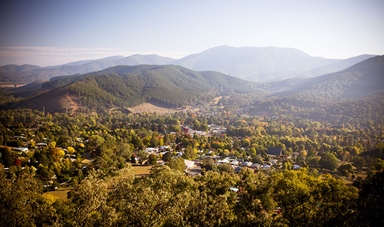Loading component...
At a glance
By Zilla Efrat
A new report suggests that a government-led insurance scheme, similar to the Medicare model, could be the most ethical way of combating the risk of thousands of homes becoming uninsurable because of climate change.
With climate extremes increasing at an alarming rate, including those that exacerbate bushfires, more than 445,000 Australian homes are predicted to be uninsurable within 30 years, according to the Social Justice and the Future of Fire Insurance in Australia report. This number is expected to jump to 718,000 by 2100.
“We can’t leave this to the market just as we can’t leave COVID-19 to the market,” says Professor Jeremy Moss, a director of the Practical Justice Initiative at the University of New South Wales (UNSW Sydney) which compiled the report.
“Doing this would introduce too many disadvantages and inequalities, particularly for already vulnerable people.”
The report explains that an entire area – NSW’s bushfire-prone Blue Mountains, for example – could suddenly lose insurance cover because of its fire risks.
This “postcode ban” could then drastically lower property values within the area. As a result, lower income groups might move to the area while more sought-after areas become the preserve of the rich.
“That’s why we need to think of a different way of insuring bushfire risk,” says Moss, Professor of Political Philosophy at UNSW.
“The aim of the study was to start a discussion and come up with a framework for developing a fair system of bushfire insurance. There are lots of examples of frameworks we could look at, such as that for earthquakes in New Zealand, Compulsory Third Party in NSW or flood insurance in the United Kingdom and the Netherlands.
“Medicare-type health insurance schemes exist in many countries, especially in Europe, providing treatment to individuals at low or no cost, regardless of their risks and choices.
We believe they help stop an increase in inequality.”
Accountants’ views of the challenges of bushfire insurance
“The problem with this model is that voters will generally accept things that they all benefit from, but I don’t know if they will buy into a government-subsidised scheme to help people who have chosen to buy in a bushfire-prone area, says Grant Moss CPA, a partner at Beaver Novello Moss in Tuncurry, NSW.
“On the other hand, everyone believes healthcare is a universal right.”
Michelle McDowall FCPA is principal of Arabon Accountants in Sherwood, Queensland, and CFO of Binna Burra Lodge in the Gold Coast hinterland. Many of her clients were affected by catastrophic bushfires in September and the lodge was all but destroyed.
“A universal insurance scheme will have its own challenges,” she says.
“A further challenge will be for homes that are strata titled as the current Queensland legislation imposes a huge burden on body corporates as it removes the choice of self-insurance even when premiums increase tenfold.”
Grant Moss explains the insurance risks with which his clients may need help.
“In NSW, many existing homes in bushfire-prone areas were constructed prior to the introduction of the bushfire-prone area construction codes,” he says.
“Many of these homeowners have not updated their policies to cover the additional cost of constructing replacement houses under the bushfire prone area construction codes and as a result, will either have to fund the additional replacement cost from alternative sources or simply receive a cash insurance payout and sell up and move on.
“I built a house in a bushfire-prone area in 2003 and the extra cost of construction to comply with the code was around $90,000.”
Grant Moss adds: “During the global financial crisis, property [values] in our area dropped by about 30 per cent. This meant that a lot of businesses failed their annual covenants on their loans and had to refinance. Some businesses had to walk away because they couldn’t refinance.
“Many business owners use their properties as security for business loans and their covenants may be breached because they are underinsured or refused insurance because of the bushfire risks.”
Pros, cons and solutions
Campbell Fuller, head of communications and media relations at the Insurance Council of Australia (ICA), says natural disaster insurance pools have been examined and rejected many times.
“Pools tend to expose governments to huge financial risk and saddle policyholders and communities with unfair costs and additional bureaucracy,” he says.
“Pools do not reduce the underlying risk and modelling suggests they have only a limited impact on premiums.”
However, Fuller adds that the insurance industry is open to sensible proposals and has also said it will assist the federal government in exploring the feasibility of a government-funded cyclone pool for northern Australia.
“The ICA believes other solutions would be fairer and more effective in ensuring the long-term sustainability of communities in high-risk areas and reducing premium pressures,” he says.
“The ultimate goal should be to protect at-risk communities through physical mitigation infrastructure and improved policy settings relating to building codes, risk-appropriate land use planning, and the removal of state taxes and levies that have a significant impact on insurance affordability.”
The ICA notes taxes add 19 to 21 per cent to the cost of insurance in most states and territories. The abolition of unfair stamp duties would immediately slash premiums by 9 to 11 per cent.
In NSW, the combined impact of the GST, stamp duties and the Emergency Services Levy results in households typically paying more than 50 per cent tax on policies, which is a direct disincentive for families to be properly insured, and 70 per cent for NSW small businesses.

